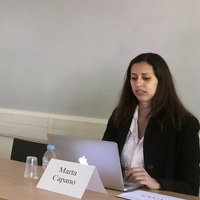- Istituto Universitario Orientale, Napoli, Italy, Dipartimento di Asia, Africa e Mediterraneo, Department MemberUniversità di Pisa, Dipartimento di Filologia, Letteratura e Linguistica, Graduate StudentUniversiteit Gent, Department of Linguistics, Post-Docadd
- Literature, Languages and Linguistics, Linguistics, Sociolinguistics, Latin Language and Literature, Historical Linguistics, and 46 moreLinguistic Typology, Etymology, Passive voice, Greek Literature, Sanskrit language and literature, Vedic Studies, Dialectology, Ancient Greek Language, Cleft Sentence, Language Variation and Change, Greek Tragedy, Grammaticalization, Ancient Greek Theatre, Areal linguistics, Passive, Agentivity, Perfect, Impersonal, Ancient Greek History, Textual Criticism, Latin Epigraphy, Greek Language, Greek Lyric Poetry, Transitivity, Indo-European Linguistics, Historical Syntax, Hittite, Word order, Indo-European Studies, Greek Linguistics, Vedic Language and Classical Sanskrit, Ancient Indo-European Languages, Comparative Indo-European Linguistics, Greek Sicily, Greek Colonization (Magna Graecia and Sicily), Archaeology of Magna Graecia and Sicily, Magna Grecia, Sicilian-Greek Interaction, Epicharmus, Ancient Greek Dialects, Tsakonian Dialect, Doric dialect, Loanwords, Language contact & change, Linguistic Areas, Cross-Linguistic Interference, and Linguistic interferenceedit
Abstract of the paper presented at the conference "Variation and Contact in the Ancient Indo-European languages: between Linguistics and Philology/ Variazione e contatto nelle lingue indoeuropee antiche: fra linguistica e filologia. Joint... more
Abstract of the paper presented at the conference "Variation and Contact in the Ancient Indo-European languages: between Linguistics and Philology/
Variazione e contatto nelle lingue indoeuropee antiche: fra linguistica e filologia. Joint Colloquia in Indo-European Linguistics"
Pisa, 19-20 April 2018.
Oxford, 17-18 May 2018
Variazione e contatto nelle lingue indoeuropee antiche: fra linguistica e filologia. Joint Colloquia in Indo-European Linguistics"
Pisa, 19-20 April 2018.
Oxford, 17-18 May 2018
Research Interests:
The Ancient Greek datives in -essi have posed a longstanding challenge in Greek linguistics, with their traditional categorisation as ‘Aeolic’ but their widespread presence across Aeolic and non-Aeolic regions. This article investigates... more
The Ancient Greek datives in -essi have posed a longstanding challenge in Greek linguistics, with their traditional categorisation as ‘Aeolic’ but their widespread presence across Aeolic and non-Aeolic regions. This article investigates the origin and diffusion of this trait, examining both the early Greek evidence (in particular the Lesbian poets, Homer, and Mycenaean Greek) and that from specific areas, namely Sicily and Pamphylia, which are often overlooked despite their history of language contact. We argue that it is not necessary to have a single explanation for the origin and spread of -essi and that independent innovations in Greek dialects better account for the material. Despite the lack of a unitary account, we suggest that something comparable to the concept of “drift” could underlie such a development. By analysing the epigraphic evidence from Sicily and Pamphylia, we conclude that the presence of -essi cannot be solely attributed to contact in all the areas in which it is attested. This perspective challenges the notion of -essi as a strong dialectal isogloss useful for diachronic dialectal taxonomy. More generally, this case study confirms the importance of considering diachronic typology and language contact to gain a more comprehensive understanding of language change.
Research Interests:
Research Interests:
My PhD dissertation (Università degli Studi di Napoli L’Orientale), entitled “Il greco in Sicilia fra età ellenistica e tarda antichità. Un contributo da un corpus epigrafico” (transl. “The Greek language in Sicily between the Hellenistic... more
My PhD dissertation (Università degli Studi di Napoli L’Orientale), entitled “Il greco in Sicilia fra età ellenistica e tarda antichità. Un contributo da un corpus epigrafico” (transl. “The Greek language in Sicily between the Hellenistic Period and Late Antiquity. A contribution from an epigraphic corpus”) offers a comprehensive analysis of the Greek language in post-classical Sicilian inscriptions, paying specific attention to the contact with other languages—especially Latin—and to the lexical and formulaic specificities of Christian epigraphy.
Research Interests:
My PhD dissertation (Università degli Studi di Napoli L'Orientale), entitled "Il greco in Sicilia fra età ellenistica e tarda antichità. Un contributo da un corpus epigrafico" (transl. "The Greek language in Sicily between the Hellenistic... more
My PhD dissertation (Università degli Studi di Napoli L'Orientale), entitled "Il greco in Sicilia fra età ellenistica e tarda antichità. Un contributo da un corpus epigrafico" (transl. "The Greek language in Sicily between the Hellenistic Period and Late Antiquity. A contribution from an epigraphic corpus") offers a comprehensive analysis of the Greek language in post-classical Sicilian inscriptions, paying specific attention to the contact with other languages-especially Latin-and to the lexical and formulaic specificities of Christian epigraphy.
